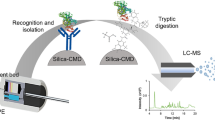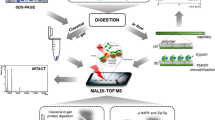Abstract
This paper describes use of a novel glass bead-based immobilized-enzyme micro column for simple and swift on-line protein digestion then peptide separation by reversed-phase HPLC. The inexpensive and easily made immobilized-enzyme micro column was prepared from aminopropyl controlled-pore glass that was reacted first with glutaraldehyde then with trypsin in the presence of phosphate buffer. Tryptic digestion of bovine serum albumin (BSA) was achieved simply by passing pretreated protein solution through the laboratory made immobilized-trypsin column; the tryptic fragments were then separated by reversed-phase HPLC. The peptide separation was found to be identical to separation of a sample which had undergone conventional enzymatic protein digestion in solution. Digestion of BSA by the immobilized-trypsin column decreased with increasing flow rate of the solution through the column, and 1.0 μL min−1 was found to be the optimum flow rate for on-line protein digestion with our system. It was also found that the sample required pretreatment with urea before injection, because of a change in the properties of the protein in the presence of urea, and the immobilized-trypsin column lost its function in the presence of acetonitrile. This on-line proteomics system enables simple and rapid protein digestion and was successfully applied to partially micro two-dimensional (2D) chromatographic separation of proteins.









Similar content being viewed by others
References
Walz T, Grigorieff N (1998) J Struct Biol 121:142–161
Turner BG, Summers MF (1999) J Mol Biol 285:1–32
Nägele E, Vollmer M, Hörth P (2003) J Chromatogr A 1009:197–205
Brugière S, Kowalski S, Ferro M, Seigneurin-Berny D, Miras S, Salvi D, Ravanel S, d’Hérin P, Garin J, Bourguignon J, Joyard J, Rolland N (2004) Phytochemistry 65:1693–1707
Williams JG, Tomer KB (2004) J Am Soc Mass Spectrom 15:1333–1340
Manso MA, Léonil J, Piot M, Gagnaire V (2005) 105:119–129
Amankwa LN, Kuhr WG (1992) Anal Chem 64(14):1610–1613
Wang C, Oleschuk R, Ouchen F, Li J, Thibault P, Harrison DJ (2000) Rapid Commun Mass Spectrom 14(15):1377–1383
Sakai-Kato K, Kato M, Toyo’oka T (2003) Anal Chem 75(3):388–393
Tyan YC, Liao JD, Jong SB, Liao PC, Yang MH, Chang YW, Klauser R, Himmelhaus M, Grunze M (2004) J Biomed Mater Res 71A(1):90–97
Emmer A, Roeraade J (2005) Anal Chim Acta 542(2):137–143
Malmsten M, Xing K, Ljunglöf A (1999) J Colloid Interface Sci 220:436–442
Krogh TN, Berg T, Højrup P (1999) Anal Biochem 274:153–162
Bonneil E, Waldron KC (2000) Talanta 53:687–699
Freije JR, Mulder PPMFA, Werkman W, Rieux L, Niederlander HAG, Verpoorte E, Bischoff R (2005) J Proteome Res 4(5):1805–1813
Jiang Y, Lee CS (2001) J Chromatogr A 924:315–322
Li Y, Cooper JW, Lee CS (2002) J Chromatogr A 979:214–247
Bengtsson M, Ekström S, Marko-Varga G, Laurell T (2002) Talanta 56:341–353
Massolini G, Calleri E, Lavecchia A, Loiodice F, Lubda D, Temporini C, Fracchiolla G, Tortorella P, Novellino E, Caccialanza G (2002) Anal Chem 75(3) 535–542
Calleri E, Temporini C, Perani E, Stella C, Rudaz S, Lubda D, Mellerio G, Veuthey JL, Caccialanza G, Massolini G (2004) J Chromatogr A 1045:99–109
Takeuchi T, Ishii D (1981) J Chromatogr 213:25–32
Tokyo Kagaku Doujin (1st ed) Encyclopedic Dictionary of Chemistry. Tokyo, p 367b
Acknowledgements
This work was partially supported by the Ministry of Education, Culture, Sports, Science and Technology, Grant-in-Aid for Scientific Research (C), No. 16550071, 2005.
Author information
Authors and Affiliations
Corresponding author
Rights and permissions
About this article
Cite this article
Lim, L.W., Tomatsu, M. & Takeuchi, T. Development of an on-line immobilized-enzyme reversed-phase HPLC method for protein digestion and peptide separation. Anal Bioanal Chem 386, 614–620 (2006). https://doi.org/10.1007/s00216-006-0458-6
Received:
Revised:
Accepted:
Published:
Issue Date:
DOI: https://doi.org/10.1007/s00216-006-0458-6




